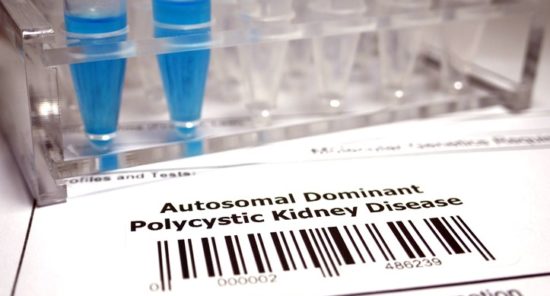Credit: Original article published here.Health-related quality of life (HRQoL) is adversely affected in patients with autosomal dominant polycystic kidney disease (ADPKD) as the disease progresses. Eric Davenport, MEcon, MStat, and colleagues conducted an analysis to describe disease burden and progression of ADPKD in young adults. Results were reported during a poster session at the National Kidney Foundation Spring Clinical Meetings 2023. The poster was titled Disease Burden and Disease Progression of Young Adult Patients With Autosomal Dominant Polycystic Kidney Disease. The analysis included data from the OVERTURE (NCT01430494) study. OVERTURE was an observational, longitudinal study of patients with ADPKD that assessed total kidney volume (TKV), estimated glomerular filtration rate (eGFR), and other disease outcomes, as well as patient-reported measures of HRQoL. Measures of HRQoL were obtained using the 12-Item Short Form Health Survey (SF-12v2) Mental and Physical Component Summaries (MCS and PCS) and the Brief Pain Inventory (BPI) and ADPKD-specific questionnaires (ADPKD Impact Scale [ADPKD-IS] and ADPKD Urinary Impact Scale [ADPKD-UIS]). The data were summarized by age group, sex, and number of visits. The analysis cohort included 93 eligible patients 18 to <22 years of age and 132 patients 22 to <26 years of age at baseline. In each group,
Credit: Original article published here.The most common renal replacement therapies for patients with end-stage renal disease (ESRD) are peritoneal dialysis and hemodialysis. More than 500,000 individuals in China are receiving dialysis treatment, and more than 90% of patients on dialysis experience renal anemia. Anemia has been associated with increased risk for cardiovascular complications, diminished quality of life, and mortality. Insufficient erythropoietin (EPO), iron deficiency, and inflammation are among the main causes of renal anemia. In the past 30 years, erythropoiesis-stimulating agents (ESAs) have been used to treat EPO deficiency. However, for patients with poor initial responses to ESAs, increasing the dose to achieve target hemoglobin levels has been associated with an increase in the risk of cardiovascualr events and death. Approximately 10% of patients treated with ESAs have EPO hyporesponsiveness, defined as a sustained substandard hemoglobin (<10.0 g/dL), despite sufficient iron levels (ferritin >100 ng/dL), and exogenous EPO administration (≥6000 IU/week). Management of patients with EPO hyporesponsiveness is challenging. When activated, hypoxia-inducible factors (HIFs) induce the production of EPO. Roxadustat is a prolyl hydroxylase inhibitor that can simulate hypoxic stimulation to stabilize HIF expression under normoxic conditions. Junjie Chen, MD, and colleagues conducted a single center, before and after treatment,
Credit: Original article published here.The most common inherited kidney disease is autosomal dominant polycystic kidney disease(ADPKD). According to Shunlai Shang, PhD, and colleagues while next generation sequencing (NGS) technology can be used to sequence tens of thousands of DNA molecules simultaneously, it has poor capture efficiency got the six PKD1 pseudogenes and GC-rich regions. Consecutive deletions of exons can be detected using multiplex ligation-dependent probe amplification (MLPA). However, MLPA is less sensitive for single-base mutations. Even using those methods, pathogenic genes might not be detected in some patients the researchers said. Improving detection the detection rate of pathogenic genes is a technical problem that hinders clinical diagnosis of ADPKD. The researchers conducted a study to examine the efficacy of a novel method for the genomic analysis of PKD1 mutation in patients with ADPKD. Four pedigrees of ADPKD patients with mutation sites not identified by NGS were examined using alternative methods. Results were reported online in Frontiers in Cell and Developmental Biology [doi.org/10.3398/fcell.2022.937580]. MLPA was performed, followed by subjecting pedigrees where MLPA did not identify pathogenic genes to multiplex polymerase chain reaction (MPCR) and targeted region sequencing. The detected mutation sites were then verified by Sanger sequencing. Results demonstrated that MPLA
Credit: Original article published here.Results of previous studies have shown that tolvaptan slows expansion of kidney volume and decline in kidney function in adults with autosomal dominant polycystic kidney disease (ADPKD). According to Djalila Mekahli, MD, PhD, and colleagues, there are few data available on the efficacy and safety of treatment with tolvaptan in children and adolescents with ADPKD. The researchers reported results of a 1-year, randomized, double-blind portion of a phase 3b two-part trial being conducted at 20 academic pediatric nephrology centers [Clinical Journal of the American Society of Nephrology. 2023;18(1):36-46]. Eligibility criteria included ADPKD and estimated glomerular filtration rate ≥60 mL/min/1.73 m2. The target group was patients 12 to 17 years of age (group 1, enrollment goal >60); patients 4 to 11 years of age could additionally enroll (group 2, anticipated enrollment approximately 40). Participants received either tolvaptan or placebo titrated by body weight and tolerability. The primary end points of interest were change from baseline in spot urine osmolality and specific gravity at week 1, and assessed inhibition of antidiuretic hormone activity. Secondary end points included change in height-adjusted total kidney volume (htTKV) to month 12 in group 1, safety and tolerability, and quality of life. Statistical



